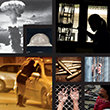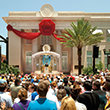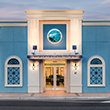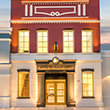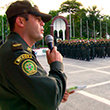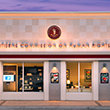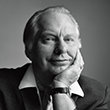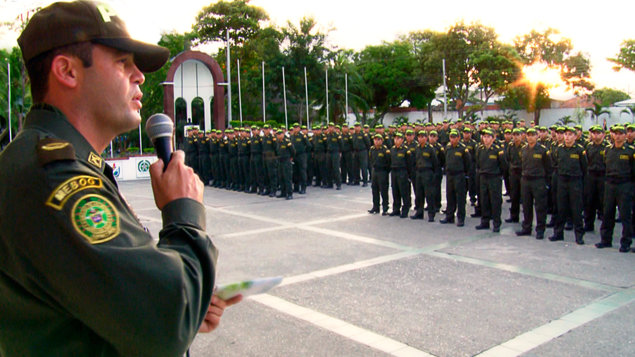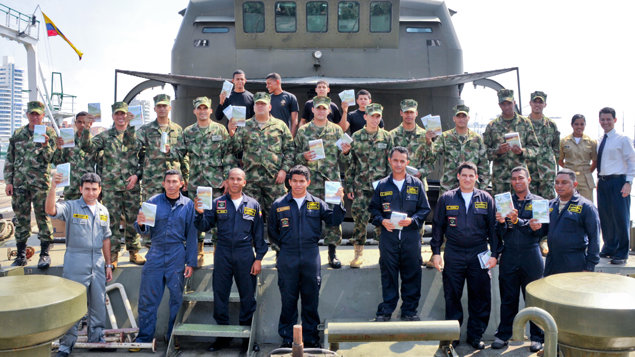A violent war-torn Gomorrah of cartels and corruption, danger and drug lords, mayhem, murder and madness, fueled by obsessive trafficking of everything from sex and cocaine to children for slavery and guns for guerrillas, Colombia spent 70 repulsive years of political dysfunction and psycho-social conflict as “the worst humanitarian crisis in the Western Hemisphere.”
So proclaimed the United Nations in 2004, when Colombia’s two largest cities—Bogotá and Medellin, home to one of every six Colombians—ranked as two of the most violent places on Earth. In the 15 years before the U.N. assessment, 200 bombs blew up cities and cars. Four presidential candidates, 200 judges and investigators, half the Supreme Court’s justices, 1,200 police officers, 151 journalists, and more than 300,000 Colombian citizens were murdered. Hundreds more were kidnapped.
That grim profile was on the mind of Guillermo Smythe, public affairs director for the Church of Scientology Motor Vessel Freewinds, when the religious retreat ship cruised into Colombia’s Cartagena Harbor in August 2008 for a refit. His assignment included the safety and security of the ship and crew while in dry dock.
But by the time the ship sailed out of the port 10 months later, it had not only accomplished its own marine makeover without incident; it had left the transformative power of The Way to Happiness common-sense moral code in its wake. The millions of illustrated copies of the booklet—written by L. Ron Hubbard and handed out across Colombia by the ship’s crew and Colombian police—had touched the very soul of Colombia. Reaching across generations mired in hopelessness, from gangbangers to tobacco farmers, the booklet’s 21 precepts inspired them to embrace the new and unique government social programs now known as the Colombia Miracle: the incredible renovation of the most wicked territory on Planet Earth.
In calling on key government officials upon his arrival, Smythe met Col. Ricardo Prado of the Colombian National Police Juvenile Division, and they struck a common bond immediately. “He was trying to figure out how to stop the recruitment of children into the guerrillas, the FARC [the Revolutionary Armed Forces of Colombia],” recalls Smythe.
Prado told Smythe horror stories of having to defend a town against FARC forces whose system was to send the child soldiers, some as young as 8, to the front lines first, then the women, then the regular army. When Prado balked at killing gun-toting “enemy” children, he was sent back to Bogotá to head the Juvenile Division. It was a dark time for Prado, says Smythe: “At that point in the Colombian police, if you were not killing the bad guys, you were not a police officer. They were like, ‘You’re a coward.’”
Col. Prado seized the opportunity afforded him in his new post and took his campaign directly into schools to reach children and forewarn them about the guerrilla forces recruitment tactics. In many cases, FARC recruiters had been there already, and the children only wanted to talk guns and killing.
A captured FARC recruiter told Prado how the guerrillas worked the system: “These kids are worthless and not educated. They don’t know anything, they’re ignorant and there are some problems in the family sometimes. They don’t have money or whatever, so we come there. We tell them we’re kind of like Robin Hood. We’re gonna give ‘em power, we’re gonna give ‘em cell phones, we give ‘em a weapon, and we’re gonna save our country now. Of course they follow us. Once they’re in, they cannot leave.”
Prado continued searching for solutions to the child soldier tragedy, and the first ray of hope came from a comedy show. Just prior to meeting Smythe, Prado had been assigned to bring a 200-man police unit to a comedy show presented by famous Colombian comedian Andrés López—known as the “Seinfeld of Colombia.”
In 2004, in response to a request from an Air Force general to help boost morale among beleaguered troops, López agreed to perform and talk about The Way to Happiness, which he had dedicated himself to making well known in his country. Since then, with the blessing of top leaders including President Uribe, Lopez has brought The Way to Happiness to tens of thousands of citizens, and to many of the country’s top civil and military officials.
His Bob Hope-style shows, for both drug cartel-chasing Colombian troops and public concert-goers, included giving a copy of the booklet to each attendee. López spoke of the result: “With The Way to Happiness I was part of the solution of the narco-political crisis in Latin America. At this point I knew I could create a stronger effect.”
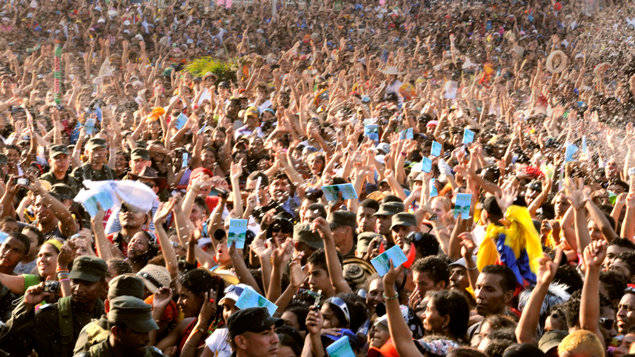
Col. Prado came away from Lopez’ show deeply impressed and with a solution to his mission to save Colombia’s children, and today he says: “He has accomplished changing Colombia. Every person that gives their grain of sand turns that grain of sand, one way or another, into a brick and that brick into a house and that house into a building and we’ve changed the world. That’s what we want.”
Soon after seeing the Lopez performance and learning of The Way to Happiness, Prado met Smythe who gave him a video presentation of the precepts. Watching it with his wife and children, he was struck by their emotional reactions, and his own. He told Smythe he had personal realizations from it that would improve his own family life as well as his police work.
With Smythe’s help, Prado presented a seminar on The Way to Happiness to his personal police staff. Again, the reaction startled him: “Policemen admitting they weren’t doing their job, and that they wanted to change.”
Soon after, activists announced a large-scale civil disturbance in Bogotá, with 100,000 protesters expected and threats to burn the presidential palace. When Prado was placed on special assignment to protect the area, he used The Way to Happiness as part of the operation. Prado deployed riot police in full gear in a ring around the Palace, ready to defend it against attack.
He also stationed units of officers in strategic positions—and without riot gear—to pass out copies of The Way to Happiness to the front lines of the hordes coming to riot. Smythe recalls: “As the protestors arrived, this small group of Prado’s police were giving out The Way to Happiness, and the people were reading it. By the time they were supposed to get violent, they kind of refused, because they had just read The Way to Happiness and decided to put in writing what they wanted from the government—and they left.”
Smythe says 50,000 booklets were given out that day and that Col. Prado “realized that this book was not just a nice little book, but that it could change people’s ideas or minds very quickly in a positive way.”
Smythe says that from that day on, Prado would pick him up, with police trucks full of The Way to Happiness booklets, and say, ‘OK, Guillermo, today we are going to this place where we’re having a little bit of trouble.’” They would caravan to a strife-ridden location, the police would fan out across the area, and to the astonishment of the locals, give them a booklet and a smile. The stunned response was followed by measurable drops in crime and violence.
Then came a major test for Col. Prado’s new brand of policing: the annual Carnaval de Barranquilla in February 2009, a Mardi Gras-like four days of intense festivities leading up to Ash Wednesday and the beginning of Lent. An important cultural and economic event for the country, with a million people taking part, it also had become known for high levels of drug use and crime, and Prado had his work cut out for him to keep it under control.
Prado and Smythe joined forces to bring The Way to Happiness to Carnaval. Smythe called stateside and a global alert went out for half a million copies. Within a week, 40-foot containers filled with The Way to Happiness arrived by barge to Cartagena. Prado deployed 2,000 Colombian police officers who in three days handed out 500,000 booklets.
The result? For the first time in the history of Carnaval, crime statistics went down, plummeting 50 percent from the previous year, according to police reports. Response to the Carnaval crime drop was overwhelming, says Smythe: “Pretty much everybody was asking for help. When they started seeing the results—the crime rates dropping so fast—everybody was asking, ‘What the hell?’”
From there, demand for “training the trainers” in how to implement The Way to Happiness skyrocketed. Seminars were held at every possible location, including the Freewinds while in drydock, for police trainers, military trainers, and teachers, who together have reached 6 million Colombians with the program.
Smythe observed that The Way to Happiness struck a common “deplorable situations” nerve in Colombia. “They knew that something had to change and they were looking for answers. Nobody was safe. If you were a policeman, your head had a price, and sometimes your own people, your friends, would kill you for the money. Even the bad guys that had all the money were worried about their own families. The country had hit bottom. When they saw The Way to Happiness, it was ‘Oh my God, this is it.’”
The chief of Cartagena’s Airport Police, Fernando Rojas, said the booklet changed his thinking and his approach to his job. “We face and absorb the problems of society to the point that one starts feeling mentally and spiritually tired. Sometimes we find ourselves not knowing what to do. After I found The Way to Happiness, I read it and re-read it. I then started distributing it to passengers coming and going at the airport. It changed the way I think. It keeps me motivated constantly and I want that for others.”
The Minister of Defense adopted the program as an official program for all Colombian military forces.
According to one police official, they took The Way to Happiness into prisons “run by barbaric guards and gangs and to little towns where they have monuments for the bad guys—where the people had been brainwashed for so long that the people thought the bad guys were the good people.”
And everywhere The Way to Happiness went, the Colombia Miracle followed:
2009: 110 murders per 100,000 people—0.11 percent
2014: 26.7 murders per 100,000 people—less than 0.03 percent and lowest in decades
Col. Prado said “I found that the fundamental tool is The Way to Happiness. And through it, I realized it could not only transform our country, but it could work in any community in Latin America and any other place in the world. It is truly universal.”


